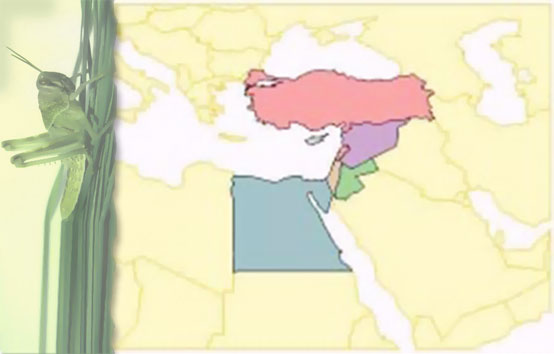Raphidopalpa foveicollis (Lucas)
(Also known as Aulacophora foveicollis (Lucas))
Common name: Red pumpkin beetle.
Taxonomic placing: Insecta, Holometabola, Coleoptera, Chrysomelidae.
Geographic distribution: Southern Europe, Mediterranean region, Asia, Australia and Africa.
Morphology: The body of the adult is 6-8 mm long. The elytra are pale orange to dark red, and the abdomen is black with white hairs. The larvae (called grubs) live in the soil, are slender, creamy yellow with pale brown heads, up to 15 mm in length.
Host plants: Raphidopalpa a foveicollis is polyphagous, attacking more than 80 plant species, mostly in the family Cucurbitaceae, especially pumpkin (Cucurbita maxima Duchesne ex Lam.).
Life history: Females lay an average of 500 eggs in the soil, close to host plants. The emerging larvae gnaw on roots and later on the foliage and fruits, preferring the flowers. They pupate in earthen chambers in the soil and complete 2-3 annual generations. Their optimal temperature is around 27–28°C.
Economic importance: This pest is most destructive in March and April, while the plants are small. Larval feeding on roots causes rot and withering. Adult feeding on seedlings can retard development and may even cause death, resulting in bare patches in the field. The beetles sometimes aggregate on and gnaw the foliage of older plants, skeletonizing them. Flowers can also suffer some damage, resulting in reduced fruit setting. The lower parts of young fruits show scars caused by adult feeding, enabling the invasion of rot-causing microorganisms. Up to 90% of the crop may be lost in some cases
Management
Monitoring: Yellow sticky traps are used for monitoring and for mass-trapping.
Horticultural methods: Light irrigation that does not moistened the roots may kill the eggs due to desiccation.
Plant resistance: Cucurbit species and cultivars with low concentrations of the feeding stimulant cucurbitacin appear to be associated with resistance. Cucurbits with shorter trichomes and those with higher levels of triterpenes are attacked to a lesser degree. Several beetle-resistant muskmelon cultivars are being bred.
Chemical control: Neem and carbamates provided good control, as did extracts of the plant Parthenium hysterophorus L. (Asteraceae)..
Biological Control: Several natural enemies attack the beetle in different parts of the world. These include the tachinid Medinodexia morgana (Hardy) and the reduviid Rhinocoris fuscipes Fabricius. Bacteria and nematodes may also kill the pest in laboratory trials, as did as the entomopathogenic fungus Beauveria bassiana (Bals.-Criv.) Vuill. ) in the field.
REFERENCES
Ali, H., Ahmad, S., Hassan, G., Amin, A. and Naeem, N. 2011. Efficacy of different botanicals against red pumpkin beetle (Aulacophora foveicollis) in bitter gourd (Momordica charantia L.). Pakistan Journal of Weed Science Research 17: 65-71.
Aziz, M.A. 2009. On the biology and host preference of Aulacophora foveicollis (Lucas). Zeitschrift für Angewandte Entomologie 94: 82–86.
Chandravadana, M.V. 1987. Identification of triterpenoid feeding deterrent of red pumpkin beetles (Aulacophora foveicollis) from Momordica charantia. Journal of Chemical Ecology 13: 1689-169.
Dhillon N.P.S. and Wehner T.C. 1987. Genetics of resistance to red pumpkin beetle (Aulacophora foveicollis) in summer squash (Cucurbita pepo L.). Theoretical and Applied Genetics 73: 711-715.
Khan, L., Shah, M. and Usman, A. 2015. Host preference of red pumpkin beetle (Aulacophora faveicollis) Lucas (Chrysomelidae: Coleoptera) among different cucurbits. Journal of Entomology and Zoology Studies 3: 100-104.
Melamed-Madjae, V. 1960. Studies on the red pumpkin beetle in Israel. Ktavim 10: 139-145.
Rashid, M.A., Khan, M.A., Arif, M.J. and Javed, N. 2014. Red pumpkin beetle, Aulacophora foveicollis Lucas; a review of host susceptibility and management practices. Academic Journal of Entomology 7: 38-54.
Shaheen, A.H. 1973. Biological studies on Aulacophora foveicollis Lucas in Egypt. Agricultural Research Review 51: 91-95.
Tariq, M., Khalid, M.K., Syed, I.H., Ghulam, I. and Laghari, M.H. 2005. Host preference of red pumpkin beetle Aulacophora (Raphidopalpa) foveicollis among cucurbits crops. Sarhad Journal of Agriculture 21: 473-475.-
Vishwakarma, R., Chand, P. and, Ghatak, S.S. 2011. Potential plant extracts and entomopathogenic fungi against red pumpkin beetle, Raphidopalpa foveicollis (Lucas). Annals of Plant Protection Sciences 19: 84-87.
Websites
